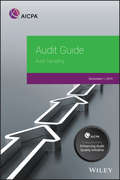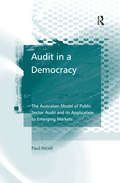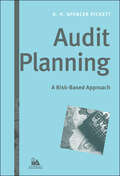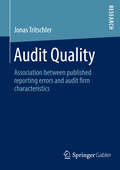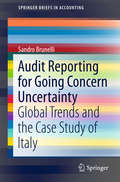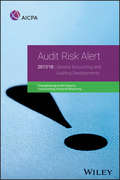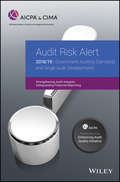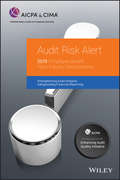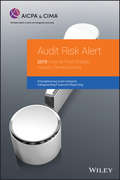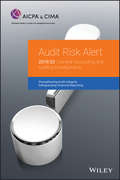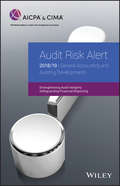- Table View
- List View
Audit Committee Essentials
by Curtis C. VerschoorPraise for Audit Committee Essentials "Audit Committee Essentials is an excellent and comprehensive resource, documented with key references and illustrated with real-life company examples for all types of commercial and nonprofit enterprises. Dr. Verschoor brings into focus the intertwined impact of risk management, internal controls, and ethics on oversight responsibilities for both the audit committee and the entire board of directors. From my personal perspective as an audit committee member and as a director of both profit and nonprofit entities, this book should be required reading for corporate management, boards of directors, and their committees." --George K. Gill, Chairman and CEO of PetAg, Inc.; Director and member of the Investment and Audit Committees of the United Methodist Foundation of Northern Illinois "Maintaining the highest ethical standards is critical to the success of not-for-profits in today's world. Dr. Verschoor's book provides a practical, highly prescriptive approach to ensuring that governance processes meet the highest expectations of managers, employees, volunteers, contributors, and other stakeholders. I am very impressed with the readability of the book. It definitely raises one's awareness of the need for a thought-out plan that ensures strong financial and ethical credibility." --John S. Maxson, President and CEO Greater North Michigan Avenue Association, Chicago, Illinois A concise and readable account of the audit committee's roles and responsibilities The Sarbanes-Oxley Act has changed the way all corporations now operate, regardless of size. In Audit Committee Essentials, goverance expert Curtis Verschoor explains with great detail and razor-sharp precision why internal control is so critical, emphasizing financial literacy, a requirement under Sarbanes-Oxley, as well as oversight of the financial reporting process and related controls, ethics and the internal and independent audits. Written for seasoned professionals as well as newly assigned board members, Audit Committee Essentials is a vital tool in order to stay abreast of the rapidly changing governance requirements and responsibilities of audit committees.
The Audit Committee: Performing Corporate Governance
by Laura F. SpiraWhy do we need to understand audit committees? The Cadbury Committee recommended that UK companies should adopt them in response to financial scandals that have stemmed from dubious financial reporting practices. In other countries, similar commissions have made similar recommendations and audit committees are now a common institution. However, many practitioners doubt whether an audit committee really does much to ensure the integrity of a firm's financial statements because, as outsiders, members don't know enough to dig deeply beneath the numbers. The Audit Committee: Performing Corporate Governance argues that such criticism overlooks the ceremonial function of these committees. The audit committee is an arena where members can form and strengthen shifting and fragmentary networks with each other and with the external auditors. Within these networks, both consensus and independence are demonstrated, generating comfort, which legitimises the company and maintains its access to external sources of capital. The audit committee is a key part of the corporate governance structure within an organisation. Many in the UK have been patched together to meet regulatory requirements and their operation is poorly understood because few people other than their members have access to their deliberations. In this account of the world of audit committees the practitioner will find the ethnographical perspectives on ceremonial performance, consensus, independence, and comfort both familiar and different. It's like looking at a photograph of something commonplace from an unusual angle or through a strange-shaped lens.
Audit Culture: How Indicators and Rankings are Reshaping the World (Anthropology, Culture and Society)
by Cris Shore Susan Wright‘A new and compelling argument for why so many institutions continue to be spellbound by rankings and metrics – despite the cultural carnage they cause. How can we halt this “death by audit”? The authors develop a radical agenda that will strike fear into number-loving technocrats around the world’ Peter Fleming, author of Dark Academia: How Universities Die‘A powerful and definitive critical diagnosis of the effects of audit culture on individuals, organisations and society. Essential reading’ Michael Power, Professor, LSE‘A visionary book’ Marilyn Strathern, Emeritus Professor, University of CambridgeAll aspects of our work and private lives are increasingly measured and managed. But how has this ‘audit culture’ arisen and what kind of a world is it producing? Cris Shore and Susan Wright provide a timely account of the rise of the new industries of accounting, enumeration and ranking from an anthropological perspective. Audit Culture is the first book to systematically document and analyse these phenomena and their implications for democracy. The book explores how audit culture operates across a wide range of fields, including health, higher education, NGOs, finance, the automobile industry and the military. The authors build a powerful critique of contemporary public sector management in an age of neoliberal market-making, privatisation and outsourcing. They conclude by offering ideas about how to reverse its damaging effects on communities, and restore the democratic accountability that audit culture is systematically undermining.Cris Shore is Emeritus Professor of Social Anthropology at Goldsmiths, University of London, and Research Fellow at the Institute for Advanced Study, Central European University. One of his recent publications is The Shapeshifting Crown. Susan Wright is Professor of Educational Anthropology at Aarhus University, Denmark. One of her recent books is Enacting the University. Together they are co-editors of the Stanford Anthropology of Policy book series.
Audit Defense: A Management Audit Readiness Guide (Palgrave Studies in Accounting and Finance Practice)
by Ed DanterMost university undergraduate and graduate audit classes are geared towards educating prospective auditors but do not provide education for those who will be audit clients and subjected to audits. Future audit clients need to be educated as well as future auditors to ensure that there is a level playing field. Those being audited do not receive the same level of formal education as internal auditors– most client education occurs during the audit itself. The client, once subjected to an audit and faced with the consequences of a failed audit, will learn via trial and error. If left unprepared, managers can suffer financial losses and promotional setbacks; the preparation and education that is needed to be audit ready is lacking. Of interest to accounting, finance or business students and entry-level practitioners, this book provides the audit education and preparation that has been missing. It shows how to interface with auditors, helping to identify issues, exposures and risks, and adequately position current and future managers to achieve successful audits. The book also provides mock audit simulation exercises to further prepare prospective audit clients.
Audit Effectiveness: Meeting the IT Challenge
by Kamil OmotesoIn Audit Effectiveness, Dr Kamil Omoteso examines how information technology is changing the landscape for the audit profession as IT tools and techniques continue to be developed for auditors in the pursuit of quality, efficiency and effectiveness. In addition to shedding light on practical subjects such as audit automation, continuous online auditing and computer auditing, this book introduces some theory that helps explain the motivation for the use of new tools and techniques, and assists understanding of their impact on the quality of audit judgment. The book proposes a three-layered model - an integration of contingency, socio-technical systems and structuration theories - for a comprehensive understanding of IT’s impact on audit. The model advocates that the use of IT in audits is a function of certain contingent factors that determine an optimal mix of human skills and technological capabilities, which would lead to changes in the nature of auditors’ roles and outputs and audit organisations’ structures. Dr Omoteso puts forward an audit automation maturity model that can help audit firms/departments to understand their current level of IT integration and how to systematically enhance their capabilities with a view to meeting modern IT challenges - taking them from the position of mere ’followers of technology’ to that of effective ’leaders of technology’. Audit Effectiveness is for anyone practising in auditing or accounting automation, as well as for those with an academic or research interest in the challenges posed by technological advances for auditors in particular, and for managers in general.
Audit Effectiveness: Meeting the IT Challenge
by Kamil OmotesoIn Audit Effectiveness, Dr Kamil Omoteso examines how information technology is changing the landscape for the audit profession as IT tools and techniques continue to be developed for auditors in the pursuit of quality, efficiency and effectiveness. In addition to shedding light on practical subjects such as audit automation, continuous online auditing and computer auditing, this book introduces some theory that helps explain the motivation for the use of new tools and techniques, and assists understanding of their impact on the quality of audit judgment. The book proposes a three-layered model - an integration of contingency, socio-technical systems and structuration theories - for a comprehensive understanding of IT’s impact on audit. The model advocates that the use of IT in audits is a function of certain contingent factors that determine an optimal mix of human skills and technological capabilities, which would lead to changes in the nature of auditors’ roles and outputs and audit organisations’ structures. Dr Omoteso puts forward an audit automation maturity model that can help audit firms/departments to understand their current level of IT integration and how to systematically enhance their capabilities with a view to meeting modern IT challenges - taking them from the position of mere ’followers of technology’ to that of effective ’leaders of technology’. Audit Effectiveness is for anyone practising in auditing or accounting automation, as well as for those with an academic or research interest in the challenges posed by technological advances for auditors in particular, and for managers in general.
Audit Guide: Government Auditing Standards and Single Audits 2018 (AICPA Audit Guide)
by AICPAThis annual edition provides accountants and other financial professionals with assistance in understanding and applying the special considerations required in a single audit. It is an indispensable resource for auditors performing Yellow Book audits. This new edition provides up-to-date information and expert guidance on single audits and Uniform Guidance compliance audit requirements, including example auditor reports for both the reporting required under Government Auditing Standards and the Uniform Guidance compliance audit.
Audit Guide: Government Auditing Standards And Single Audits 2017 (AICPA Audit Guide)
by AICPAUpdated as of December 1, 2019, this guide continues to be an indispensable resource packed with information on sampling requirements and methods. It introduces statistical and nonstatistical sampling approaches, and features case studies illustrating the use of different sampling methods, including classical variables sampling and monetary unit sampling, in real-world situations.
Audit Guide: Sampling 2019 (AICPA Audit Guide)
by AICPAUpdated as of December 1, 2019, this guide continues to be an indispensable resource packed with information on sampling requirements and methods. It introduces statistical and nonstatistical sampling approaches, and features case studies illustrating the use of different sampling methods, including classical variables sampling and monetary unit sampling, in real-world situations.
Audit in a Democracy: The Australian Model of Public Sector Audit and its Application to Emerging Markets
by Paul NicollExploring the role of public sector audit in emerging democracies and developing countries, this book provides an account of the relationship between the public sector auditor, the legislature and executive government. In particular, it introduces public sector audit's capacity to assess government agencies' compliance with the law and their management of taxpayer or internationally funded programs and services. The volume: ¢ Explores the Australian model of public sector audit. ¢ Provides a definition of a supreme Audit Institution (SAI) and the role and responsibilities of the public sector auditor. ¢ Examines the authority necessary for the SAI to function effectively. ¢ Discusses likely future reform of the SAI's legal framework. ¢ Illustrates how audit can be used to strengthen democratic institutions in emerging market economies. It will be of use to researchers, academics and students interested in the critical issues surrounding audit in general and public sector audit in particular. It will also be a valuable guide to practitioners in this area.
Audit in a Democracy: The Australian Model of Public Sector Audit and its Application to Emerging Markets
by Paul NicollExploring the role of public sector audit in emerging democracies and developing countries, this book provides an account of the relationship between the public sector auditor, the legislature and executive government. In particular, it introduces public sector audit's capacity to assess government agencies' compliance with the law and their management of taxpayer or internationally funded programs and services. The volume: ¢ Explores the Australian model of public sector audit. ¢ Provides a definition of a supreme Audit Institution (SAI) and the role and responsibilities of the public sector auditor. ¢ Examines the authority necessary for the SAI to function effectively. ¢ Discusses likely future reform of the SAI's legal framework. ¢ Illustrates how audit can be used to strengthen democratic institutions in emerging market economies. It will be of use to researchers, academics and students interested in the critical issues surrounding audit in general and public sector audit in particular. It will also be a valuable guide to practitioners in this area.
Audit Planning: A Risk-Based Approach (IIA (Institute of Internal Auditors) Series)
by K. H. PickettMore now than ever before, auditing is in the spotlight; legislators, regulators, and top executives in all types of businesses realize the importance of auditors in the governance and performance equation. Previously routine and formulaic, internal auditing is now high-profile and high-pressure! Being an auditor in today's complex, highly regulated business environment involves more than crunching the numbers and balancing the books-it requires ensuring that appropriate checks and balances are in place to manage risk throughout the organization. Designed to help auditors in any type of business develop the essential understanding, capabilities, and tools needed to prepare credible, defensible audit plans, Audit Planning: A Risk-Based Approach helps auditors plan the audit process so that it makes a dynamic contribution to better governance, robust risk management, and more reliable controls. Invaluable to internal auditors facing new demands in the workplace, this book is also a "hands-on" reference for external auditors, compliance teams, financial controllers, consultants, executives, small business owners, and others charged with reviewing and validating corporate governance, risk management, and controls. The second book in the new Practical Auditor Series, which helps auditors get down to business, Audit Planning: A Risk-Based Approach gives new auditors principles and methodologies they can apply effectively and helps experienced auditors enhance their skills for success in the rapidly changing business world.
Audit Quality: Association between published reporting errors and audit firm characteristics
by Jonas TritschlerArising from the author’s experience as a practicing CPA, this book is quite different from other research in this field, as it confronts the subject of audit quality from a pragmatic perspective. The first goal of Jonas Tritschler is to develop an audit quality metric on national audit firm level. Financial reporting errors, as detected by the German enforcement institutions during examinations, which subsequently are published in the German Federal Gazette by the involved companies, are the data basis for this measurement. Using the developed audit quality metric, the second goal of this study is to analyze audit quality differences of selected audit firms by comparing their deployed audit input factors such as employee’s competence (ratio of certified professionals to total audit staff), experience of employees (average tenure of employees in years) and client-specific experience (client fluctuation rate). Results indicate a correlation between audit quality according to the developed metric and the operationalized audit input factors mentioned above.
Audit Reporting for Going Concern Uncertainty: Global Trends and the Case Study of Italy (SpringerBriefs in Accounting)
by Sandro BrunelliThis book employs a narrative analytical approach to explore all aspects of the debate surrounding auditor reporting on going concern uncertainty worldwide. In-depth analysis of significant academic studies and of regulatory perspectives is combined with an illuminating empirical study in the Italian context. The book opens by discussing the assessment of going concern for accounting and auditing purposes. It is examined how going concern is considered in the FASB and IASB accounting standards and how auditors in the PCAOB and IAASB environments should verify its presence in financial statements and report on it in the audit report. Accounting and auditing in relation to going concern in other jurisdictions are also addressed. Research into the determinants, accuracy, and consequences of going concern opinions (GCO) is then thoroughly reviewed, with separate examination of studies and trends in the United States, Europe, and the rest of the world. In the third part of the book, interesting evidence from the Italian Stock Market, including investor reactions to GCOs during the period 2008–2014, is presented and evaluated. The book will be of interest to academics, regulators, and practitioners alike.
Audit Risk Alert: General Accounting and Auditing Developments, 2017/18 (AICPA)
by AICPAUpdated annually, this useful resource contains a description of all recent auditing, accounting and regulatory developments to ensure that the accountant has a robust understanding of the business, economic, and regulatory environments in which they and their clients operate. In addition, this alert ensures that the accountant has a full understanding of emerging practice issues, with targeted analysis of new developments and how they may affect your engagements, including: • Recent Economic Trends • Recent Legislative and PCAOB Developments • Developments in Peer Review • Recent Ethics Interpretations It also contains new accounting and auditing guidance related to derivatives and hedging, service concession agreements, discontinued operations, stock compensation, and more
Audit Risk Alert: Government Auditing Standards and Single Audit Developments: Strengthening Audit Integrity 2018/19 (AICPA)
by AICPAThis Audit Risk Alert highlights areas of change in audits performed under the Uniform Guidance, focusing on areas which may be challenging or frequently misunderstood. It also discusses emerging practice issues and current developments related to entities subject to an audit performed under Government Auditing Standards and the OMB Uniform Guidance and provides information to help you identify significant risks that may affect an audit of entities receiving federal awards. In addition, this alert provides a summary of revision found in the 2018 Yellow Book. Updates include: The 2018 Yellow Book USDA Rural Development Dept of Education Housing and Urban Development
Audit Risk Alert: Employee Benefit Plans Industry Developments, 2019 (AICPA)
by AICPAThe increasing complexity of employee benefit plan auditing and focus by the Department of Labor have resulted in significant pressure for CPAs and firms performing EBP audits. To help CPAs meet the challenge of performing quality audits in this unique and complex area, the AICPA has developed this alert to assist in identifying current sources of risk within EBP audit engagements. Written by a task force consisting of current and former employee benefit plan expert panel members, this alert features discussions on new developments and issues that auditors may face in their current audits, as well as a look at what's in the pipeline that may affect your engagements. Updates in 2019: FASB ASU No. 2017-06, Employee Benefit Plan Master Trust Reporting FASB ASU No. 2018-09, Codification Improvements FASB ASU No. 2018-13, Fair Value Measurement (Topic 820), Disclosure Framework–Changes to the Disclosure Requirements for Fair Value Measurement
Audit Risk Alert: Not-for-Profit Entities Industry Developments, 2019 (AICPA Audit and Accounting Guide)
by AICPANot-for-profit auditor have a lot to consider as they navigate the pace of change in today's complex business environment. Many finance professionals serving the nonprofit sector are challenged with implementation of significant new accounting standards under U.S. GAAP, such as revenue recognition and accounting for not-for-profit grants and contracts. Created for nonprofit finance and accounting staff, auditors, and board members alike, this alert features the most important developments affecting not-for-profit entities and the key issues auditors may face. This guide covers all the changes on the horizon, including business environment issues like: Cybersecurity and outsourcing Accounting and auditing challenges (e.g., the implementation of FASB's not-for-profit financial statement presentation) Revenue recognition Leases standards Delivered in an easily digestible format, this alert also covers legislative and regulatory issues such as unrelated business income tax, the "parking tax," and changes to IRS Form 990-T, as well as a discussion of the upcoming changes to the auditor's report.
Audit Risk Alert: Government Auditing Standards and Single Audit Developments: Strengthening Audit Integrity 2018/19 (AICPA)
by AICPAThis Audit Risk Alert highlights areas of change in audits performed under the Uniform Guidance, focusing on areas which may be challenging or frequently misunderstood. It also discusses emerging practice issues and current developments related to entities subject to an audit performed under Government Auditing Standards and the OMB Uniform Guidance and provides information to help you identify significant risks that may affect an audit of entities receiving federal awards. In addition, this alert provides a summary of revision found in the 2018 Yellow Book. Updates include: The 2018 Yellow Book USDA Rural Development Dept of Education Housing and Urban Development
Audit Risk Alert: Employee Benefit Plans Industry Developments, 2019 (AICPA)
by AICPAThe increasing complexity of employee benefit plan auditing and focus by the Department of Labor have resulted in significant pressure for CPAs and firms performing EBP audits. To help CPAs meet the challenge of performing quality audits in this unique and complex area, the AICPA has developed this alert to assist in identifying current sources of risk within EBP audit engagements. Written by a task force consisting of current and former employee benefit plan expert panel members, this alert features discussions on new developments and issues that auditors may face in their current audits, as well as a look at what's in the pipeline that may affect your engagements. Updates in 2019: FASB ASU No. 2017-06, Employee Benefit Plan Master Trust Reporting FASB ASU No. 2018-09, Codification Improvements FASB ASU No. 2018-13, Fair Value Measurement (Topic 820), Disclosure Framework–Changes to the Disclosure Requirements for Fair Value Measurement
Audit Risk Alert: Not-for-Profit Entities Industry Developments, 2019 (AICPA Audit and Accounting Guide)
by AICPANot-for-profit auditor have a lot to consider as they navigate the pace of change in today's complex business environment. Many finance professionals serving the nonprofit sector are challenged with implementation of significant new accounting standards under U.S. GAAP, such as revenue recognition and accounting for not-for-profit grants and contracts. Created for nonprofit finance and accounting staff, auditors, and board members alike, this alert features the most important developments affecting not-for-profit entities and the key issues auditors may face. This guide covers all the changes on the horizon, including business environment issues like: Cybersecurity and outsourcing Accounting and auditing challenges (e.g., the implementation of FASB's not-for-profit financial statement presentation) Revenue recognition Leases standards Delivered in an easily digestible format, this alert also covers legislative and regulatory issues such as unrelated business income tax, the "parking tax," and changes to IRS Form 990-T, as well as a discussion of the upcoming changes to the auditor's report.
Audit Risk Alert: General Accounting and Auditing Developments, 2017/18 (AICPA)
by AICPAUpdated annually, this useful resource contains a description of all recent auditing, accounting and regulatory developments to ensure that the accountant has a robust understanding of the business, economic, and regulatory environments in which they and their clients operate. In addition, this alert ensures that the accountant has a full understanding of emerging practice issues, with targeted analysis of new developments and how they may affect your engagements, including: • Recent Economic Trends • Recent Legislative and PCAOB Developments • Developments in Peer Review • Recent Ethics Interpretations It also contains new accounting and auditing guidance related to derivatives and hedging, service concession agreements, discontinued operations, stock compensation, and more
Audit Risk Alert: General Accounting and Auditing Developments 2019/2020 (AICPA)
by AICPAThis alert provides auditors with an overview of recent economic, industry, technical, regulatory, and professional developments that may affect how auditors conduct audits and other engagements. An entity’s internal management can also use this alert to address areas of audit concern. Updates include: Economic and Industry Developments Legislative and Regulatory Developments Audit and Attestation Issues and Developments Revenue Recognition New Lease Standard Accounting for Financial Instruments Recent AICPA Independence and Developments
Audit Risk Alert: General Accounting and Auditing Developments 2019/2020 (AICPA)
by AICPAThis alert provides auditors with an overview of recent economic, industry, technical, regulatory, and professional developments that may affect how auditors conduct audits and other engagements. An entity’s internal management can also use this alert to address areas of audit concern. Updates include: Economic and Industry Developments Legislative and Regulatory Developments Audit and Attestation Issues and Developments Revenue Recognition New Lease Standard Accounting for Financial Instruments Recent AICPA Independence and Developments
Audit Risk Alert: General Accounting and Auditing Developments 2018/19 (AICPA)
by AICPAContaining descriptions of all recent auditing, accounting and regulatory developments, this 2018 alert will ensure that accountants have a robust understanding of the business, economic, and regulatory environments in which they and their clients operate. In addition, accountants will gain a full understanding of emerging practice issues, with targeted analysis of new developments and how they may affect their engagements, including: Recent Economic Trends Recent Legislative and PCAOB Developments Developments in Peer Review Recent Ethics Interpretations This useful resource also contains new accounting and auditing guidance related: Derivatives and Hedging Service Concession Agreements Discontinued Operations Stock Compensation






